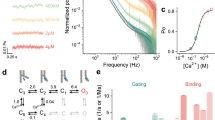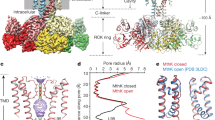Abstract
VOLTAGE-DEPENDENT Ca2+ channels respond to membrane depolarization by conformational changes that control channel opening and eventual closing by inactivation1–3. The kinetics of inactivation differ considerably between types of Ca2+ channels1–8 and are important in determining the amount of Ca2+ entry during electrical activity and its resulting impact on diverse cellular events3. The most intensively characterized forms of inacti-vation in potassium9–10 and sodium channels11–13 involve pore block by a tethered plug14. In contrast, little is known about the molecu-lar basis of Ca2+-channel inactivation. We studied the molecular mechanism of inactivation of voltage-gated calcium channels by making chimaeras from channels with different inactivation rates. We report here that the amino acids responsible for the kinetic differences are localized to membrane-spanning segment S6 of the first repeat of the ai subunit (IS6), and to putative extracellular and cytoplasmic domains flanking IS6. Involvement of this region in Ca2+ -channel inactivation was unexpected and raises interesting comparisons with Na+ channels, where the III-IV loop is a critical structural determinant. Ca2+ -channel inactivation has some features that resemble C-type inactivation of potassium channels.
This is a preview of subscription content, access via your institution
Access options
Subscribe to this journal
Receive 51 print issues and online access
$199.00 per year
only $3.90 per issue
Buy this article
- Purchase on Springer Link
- Instant access to full article PDF
Prices may be subject to local taxes which are calculated during checkout
Similar content being viewed by others
References
Carbone, E. & Swandulla, D. Prog. Biophys. molec. Biol. 54, 31–58 (1989).
Reuter, H. A. Rev. Physiol. 46, 473–484 (1984).
Hille, B. Ionic Channels of Excitable Membranes (Sinauer, Sunderland, MA, 1992).
Armstrong, C. M. & Matteson, D. R. Science 227, 65–67 (1985).
Nowycky, M. C., Fox, A. P. & Tsien, R. W. Nature 316, 440–443 (1985).
Bean, B. A. Rev. Physiol. 51, 367–384 (1989).
Llinas, R. et al. Trends Neurosci. 15, 351–355 (1992).
Ellinor, P. T. et al. Nature 363, 455–458 (1993).
Hoshi, T., Zagotta, W. N. & Aldrich, R. W. Science 250, 533–538 (1990).
Demo, S. D. & Yellen, G. Neuron 7, 743–753 (1991).
Stuhmer, W. et al. Nature 339, 597–603 (1989).
Vassilev, P., Scheuer, T. & Catterall, W. A. Proc. natn. Acad. Sci. U.S.A. 86, 8147–8151 (1989).
Catterall, W. A. Trends Neurosci. 16, 500–506 (1993).
Armstrong, C. M. & Bezanilla, F. J. gen. Physiol. 70, 567–590 (1977).
Mori, Y. et al. Nature 350, 398–402 (1991).
Mikami, A. et al. Nature 340, 230–233 (1989).
Eckert, R. & Chad, J. D. Prog. Biophys. molec. Biol. 44, 215–267 (1984).
Lacerda, A. E. et al. Nature 352, 527–530 (1991).
Singer, D. et al. Science 253, 1553–1557 (1991).
Pragnell, M. et al. Nature 368, 67–70 (1994).
Hoshi, T., Zagotta, W. N. & Aldrich, R. W. Neuron 7, 547–556 (1991).
Kirsch, G. E. et al. Biophys. J. 62, 136–143 (1992).
Choi, K. L., Aldrich, R. W. & Yellen, G. Proc. natn. Acad. Sci. U.S.A. 88, 5092–5095 (1991).
Lopez-Barneo, J. et al. Receptors Channels 1, 61–71 (1993).
Yellen, G. et al. Biophys. J. 66, 1068–1075 (1994).
Rojas, C. V. et al. Nature 354, 387–389 (1991).
Cannon, S. C. & Strittmatter, S. M. Neuron 10, 317–326 (1993).
Strichartz, G., Rando, T. & Wang, G. K. A. Rev. Neurosci. 10, 237–267 (1987).
Thomsen, W. J. & Catterall, W. A. Proc. natn. Acad. Sci. U.S.A. 86, 10161–10165 (1989).
Williams, M. E. et al. Science 257, 390–395 (1992).
Soong, T. W. et al. Science 260, 1133–1136 (1993).
Author information
Authors and Affiliations
Rights and permissions
About this article
Cite this article
Zhang, JF., Ellinor, P., Aldrich, R. et al. Molecular determinants of voltage-dependent inactivation in calcium channels. Nature 372, 97–100 (1994). https://doi.org/10.1038/372097a0
Received:
Accepted:
Issue Date:
DOI: https://doi.org/10.1038/372097a0
This article is cited by
-
Slow negative feedback enhances robustness of square-wave bursting
Journal of Computational Neuroscience (2023)
-
Introduction into Cav2.1 of the homologous mutation of Cav1.2 causing the Timothy syndrome questions the role of V421 in the phenotypic definition of P-type Ca2+ channel
Pflügers Archiv - European Journal of Physiology (2008)
-
RIM1 confers sustained activity and neurotransmitter vesicle anchoring to presynaptic Ca2+ channels
Nature Neuroscience (2007)
-
Effect of propafenone on Kv1.4 inactivation
Journal of Physiology and Biochemistry (2006)
-
Molecular regions underlying the activation of low- and high-voltage activating calcium channels
European Biophysics Journal (2005)
Comments
By submitting a comment you agree to abide by our Terms and Community Guidelines. If you find something abusive or that does not comply with our terms or guidelines please flag it as inappropriate.



